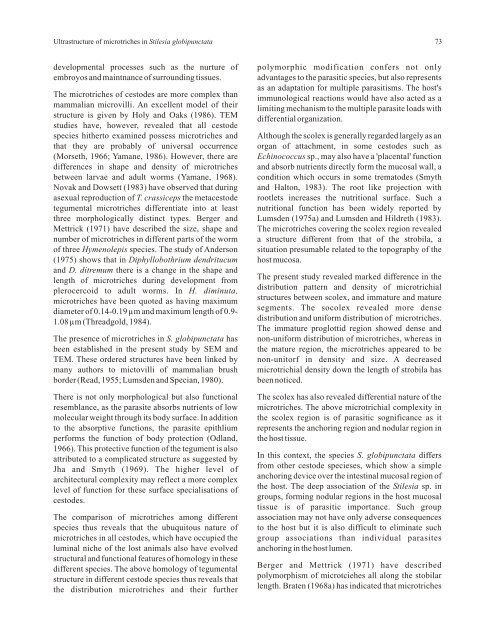PDF File - The Indian Society for Parasitology
PDF File - The Indian Society for Parasitology
PDF File - The Indian Society for Parasitology
Create successful ePaper yourself
Turn your PDF publications into a flip-book with our unique Google optimized e-Paper software.
Ultrastructure of microtriches in Stilesia globipunctata73developmental processes such as the nurture of polymorphic modification confers not onlyembroyos and maintnance of surrounding tissues. advantages to the parasitic species, but also representsas an adaptation <strong>for</strong> multiple parasitisms. <strong>The</strong> host's<strong>The</strong> microtriches of cestodes are more complex thanimmunological reactions would have also acted as amammalian microvilli. An excellent model of theirlimiting mechanism to the multiple parasite loads withstructure is given by Holy and Oaks (1986). TEMdifferential organization.studies have, however, revealed that all cestodespecies hitherto examined possess microtriches and Although the scolex is generally regarded largely as anthat they are probably of universal occurrence organ of attachment, in some cestodes such as(Morseth, 1966; Yamane, 1986). However, there are Echinococcus sp., may also have a 'placental' functiondifferences in shape and density of microtriches and absorb nutrients directly <strong>for</strong>m the mucosal wall, abetween larvae and adult worms (Yamane, 1968). condition which occurs in some trematodes (SmythNovak and Dowsett (1983) have observed that during and Halton, 1983). <strong>The</strong> root like projection withasexual reproduction of T. crassiceps the metacestode rootlets increases the nutritional surface. Such ategumental microtriches differentiate into at least nutritional function has been widely reported bythree morphologically distinct types. Berger and Lumsden (1975a) and Lumsden and Hildreth (1983).Mettrick (1971) have described the size, shape and <strong>The</strong> microtriches covering the scolex region revealednumber of microtriches in different parts of the worm a structure different from that of the strobila, aof three Hymenolepis species. <strong>The</strong> study of Anderson situation presumable related to the topography of the(1975) shows that in Diphyllobothrium dendritucum host mucosa.and D. ditremum there is a change in the shape andlength of microtriches during development from<strong>The</strong> present study revealed marked difference in theplerocercoid to adult worms. In H. diminuta,distribution pattern and density of microtrichialmicrotriches have been quoted as having maximumstructures between scolex, and immature and maturediameter of 0.14-0.19 µm and maximum length of 0.9-segments. <strong>The</strong> socolex revealed more dense1.08 µm (Threadgold, 1984).distribution and uni<strong>for</strong>m distribution of microtriches.<strong>The</strong> immature proglottid region showed dense and<strong>The</strong> presence of microtriches in S. globipunctata has non-uni<strong>for</strong>m distribution of microtriches, whereas inbeen established in the present study by SEM and the mature region, the microtriches appeared to beTEM. <strong>The</strong>se ordered structures have been linked by non-unitorf in density and size. A decreasedmany authors to mictovilli of mammalian brush microtrichial density down the length of strobila hasborder (Read, 1955; Lumsden and Specian, 1980). been noticed.<strong>The</strong>re is not only morphological but also functionalresemblance, as the parasite absorbs nutrients of lowmolecular weight through its body surface. In additionto the absorptive functions, the parasite epithliumper<strong>for</strong>ms the function of body protection (Odland,1966). This protective function of the tegument is alsoattributed to a complicated structure as suggested byJha and Smyth (1969). <strong>The</strong> higher level ofarchitectural complexity may reflect a more complexlevel of function <strong>for</strong> these surface specialisations ofcestodes.<strong>The</strong> comparison of microtriches among differentspecies thus reveals that the ubuquitous nature ofmicrotriches in all cestodes, which have occupied theluminal niche of the lost animals also have evolvedstructural and functional features of homology in thesedifferent species. <strong>The</strong> above homology of tegumentalstructure in different cestode species thus reveals thatthe distribution microtriches and their further<strong>The</strong> scolex has also revealed differential nature of themicrotriches. <strong>The</strong> above microtrichial complexity inthe scolex region is of parasitic sognificance as itrepresents the anchoring region and nodular region inthe host tissue.In this context, the species S. globipunctata differsfrom other cestode specieses, which show a simpleanchoring device over the intestinal mucosal region ofthe host. <strong>The</strong> deep association of the Stilesia sp. ingroups, <strong>for</strong>ming nodular regions in the host mucosaltissue is of parasitic importance. Such groupassociation may not have only adverse consequencesto the host but it is also difficult to eliminate suchgroup associations than individual parasitesanchoring in the host lumen.Berger and Mettrick (1971) have describedpolymorphism of microtciehes all along the stobilarlength. Braten (1968a) has indicated that microtriches










